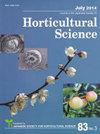二倍体芦笋(Asparagus officinalis L.)杂交产生自发性三倍体后代的研究SSR标记确定植物及其起源
Journal of The Japanese Society for Horticultural Science
Pub Date : 2014-07-18
DOI:10.2503/JJSHS1.CH-073
引用次数: 4
摘要
利用SSR和流式细胞分析技术对从2x × 2x杂交中获得的芦笋自发性三倍体植株的来源进行了研究。以二倍体雌性“金沙茨”与二倍体雄性“北海100”杂交获得124个子代。SSR分析表明,在子代07M-61的每个SSR位点上,分别有2个和1个基因来自父本和母本,而在另一个二倍体子代中,各有1个基因来自父本和母本。流式细胞分析证实了07M-61的三倍体性。根据其SSR基因型,推测该三倍体植株是由未还原的卵子和还原的精子核受精而来。未减数母配子可能来源于减数分裂过程中发生交叉的第一次分裂恢复(FDR)或第二次分裂恢复(SDR)。三倍体和二倍体后代在形态上无明显差异。本文章由计算机程序翻译,如有差异,请以英文原文为准。
Occurrence of a Spontaneous Triploid Progeny from Crosses between Diploid Asparagus (Asparagus officinalis L.) Plants and Its Origin Determined by SSR Markers
The origin of a spontaneous triploid asparagus plant from crosses of 2x × 2x was investigated by SSR and flow cytometric analyses. One hundred and twenty-four progeny were obtained from crosses between a diploid female ‘Gold Schatz’ and a diploid male ‘Hokkai 100’. SSR analysis proved that two and one genes were transmitted from the maternal and paternal parents, respectively, at each SSR locus of one progeny, 07M-61, whereas one gene each was from the female and male parents in the other diploid progeny. Triploidy of 07M-61 was confirmed by flow cytometric analysis. It was suggested that the triploid plant was derived from fertilization between an unreduced egg and reduced sperm nuclei, given its SSR genotypes. It was also suggested that the unreduced maternal gamete was derived from first division restitution (FDR) or second division restitution (SDR) with chiasma occurrence during meiosis. There were no noticeable morphological differences between the triploid and diploid progeny.
求助全文
通过发布文献求助,成功后即可免费获取论文全文。
去求助
来源期刊
自引率
0.00%
发文量
0
审稿时长
>36 weeks

 求助内容:
求助内容: 应助结果提醒方式:
应助结果提醒方式:


